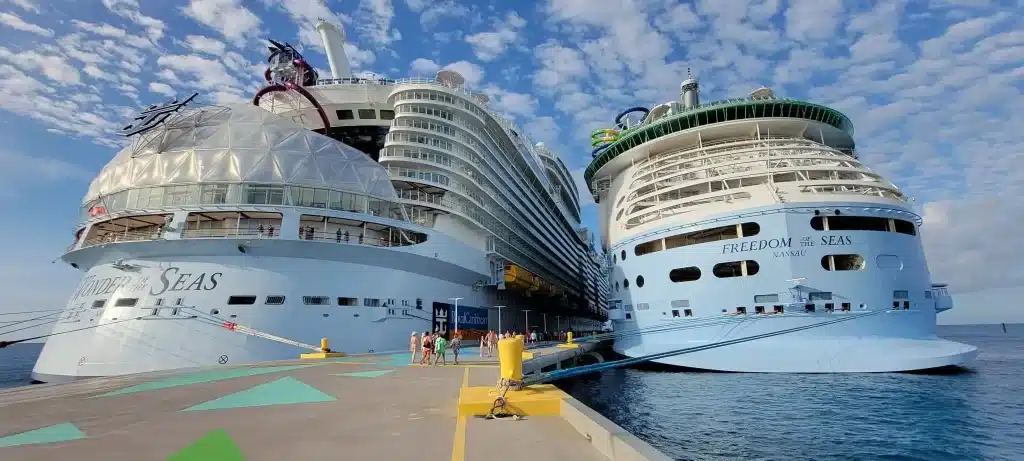Table of Contents
Introduction
Cruise ships are magnificent ocean giants that personify exploration, elegance, and adventure. These floating wonders are enormous in terms of weight and size and are feats of engineering. The enormity of these seagoing monsters strikes us when we consider the question, “How much does a cruise ship weigh?” A cruise ship can weigh up to tens of thousands of tons, an incredible amount of weight. Let’s examine and analyze the heaviest cruise ships to get a true sense of their size.
With weights comparable to small cities, the world’s heaviest cruise ships test the limits of engineering and design. These floating resorts are among the biggest manufactured constructions ever to grace the seas, weighing over 200,000 tons. To put this into perspective, consider that a cruise ship can weigh more than thousands of elephants or hundreds of commercial airplanes combined.
However, what is a cruise ship weigh in pounds? The response is astounding. The heaviest cruise ships can weigh millions of pounds or more, illustrating the enormous mass they transport across oceans. These ships are incredibly heavy due to every feature, including the expansive decks, entertainment areas, and opulent staterooms.
However, despite their enormous size and weight, cruise ships move effortlessly over the water, offering guests an unmatched level of luxury and adventure. As we learn more about cruise ships, we discover how heavy they are and how much creativity and skill went into making these floating wonders. Thus, the next time you see a cruise ship, consider how heavy it is and be in awe of its technical achievement, which enabled it to sail the oceans with such grandeur and grace.
want some fun have a look on Disney Cruise Fish Extender: Adding Extra Magic to Your Voyage

Understanding Cruise Ship Weight
Comprehending the cruise ship weigh for engineering marvels and marine safety is essential. These floating buildings have incredible weights and are among the biggest manufactured structures. A cruise ship’s weight is determined by its size, type of construction, and amenities. The biggest cruise ships in the world usually weigh 200,000 tons or more. Due to these enormous weights, advanced engineering is required to provide stability and mobility at sea—factors influencing the total weight, including fuel, cargo, and passenger capacity. A thorough understanding of cruise ship weight is essential for these famous boats’ construction, management, and upkeep.
Comprehending Cruise Ship Weight
Before getting too technical, knowing what goes into a cruise ship weigh is essential. A cruise ship’s weight comprises several parts, such as its hull, superstructure, engines, fuel, water, furniture, amenities, and passenger cargo. Each of these components largely determines the total weight of these marine monsters.
Superstructure and Hull
A cruise ship’s hull, made of durable materials like steel or aluminum to resist the harsh marine climate, serves as the structural foundation of the vessel. The superstructure, consisting of the decks, staterooms, and public areas, increases the ship’s weight and gives passengers more room for amenities and activities.
Fuel and Engines
Huge engines that can move these enormous ships across the huge ocean power these enormous ships. The engines and fuel tanks substantially add to the ship’s total weight. Cruise ships generally add to their weight by using liquefied natural gas (LNG) or heavy fuel oils to run efficiently.
Ballast and Water
Cruise ship inject ballast water into specific compartments to modify their draft and trim to maintain stability and weigh. Furthermore, freshwater tanks are necessary to supply the passengers’ and crew’s onboard water needs. The combined weight of the ship’s freshwater storage and ballast water is significant.

Interior Design and Amenities
Cruise ships are equipped with opulent furniture and services, ranging from spacious dining halls and entertainment areas to exquisite suites, all designed to guarantee the comfort and pleasure of their guests. These extras, including fixtures, furniture, and recreational amenities, significantly increase the ship’s weight.
Both Travelers and Goods
The people and cargo on a cruise ship are arguably the most dynamic portion of its weigh. When thousands of people set out on a single journey, the passengers’ total weight, belongings, and supplies can add up. Cruise ships carry a variety of supplies and items to accommodate a wide range of preferences and demands, which adds to their overall weight.
For example, Majesty of the Seas, one of the most giant cruise ships in the world, built by Royal Caribbean International, has a gross weight of about 228,081 tons. This incredible weight is the same as around 1,500 Boeing 747 aircraft or more than 35,000 African elephants. These numbers highlight the enormous magnitude of these marine wonders and the engineering skills needed to build and run them.
How Weight Affects Cruise Ship Operations
cruise ship weigh impacts its environmental impact, operating efficiency, and structural integrity. Additional fuel to propel heavier vessels increases emissions and operational expenses. Port facilities must also accommodate the weight and scale of large ships, requiring investments in resources and infrastructure.
The effects of cruise ship weight on the environment also include worries about carbon emissions, air and water pollution, and disturbance of marine habitats. Cleaner fuels, more sophisticated propulsion systems, and environmentally friendly procedures are among the measures used to lessen these effects and reduce the ecological footprint of cruise operations.
